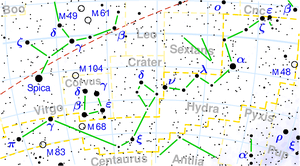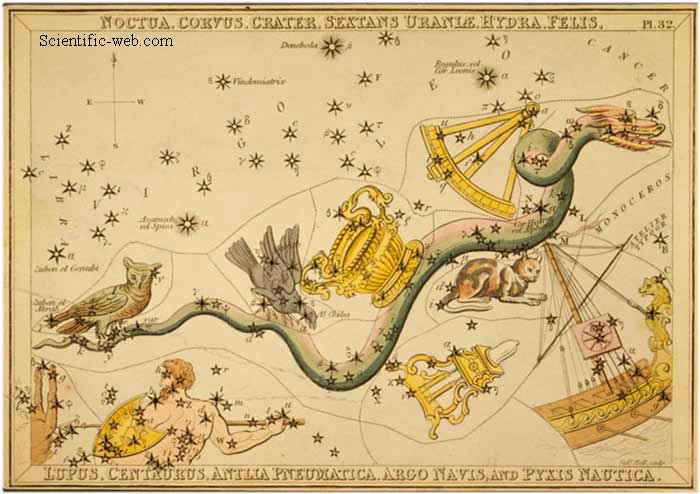|
|
Hydra is the largest of the 88 modern constellations, and was also one of the 48 constellations listed by Ptolemy. Notable features Hydra is the largest modern constellation, at 1303 square degrees. Despite its size, Hydra contains only one reasonably bright star, Alphard (α Hya, 30 Hya), which is of apparent magnitude 1.98. The other main named star in Hydra is Sigma, σ, Hydrae, which also has the name of Minaruja, from the Arabic for snake's nose. At magnitude 4.54, it is rather dim. R Hydrae is a Mira variable star that ranges in magnitude between 3.5, when it can be visible to the naked eye, to 10.9, when a telescope is required to see it. There are several double stars of interest in Hydra. Epsilon Hydrae (ε Hya) is a binary star with components of magnitudes 3.3 and 6.8, separated by 2.7 arcseconds. N Hydrae (N Hya) is a pair of stars of magnitudes 5.8 and 5.9. Struve 1270 (Σ1270) consists of a pair of stars, magnitudes 6.4 and 7.4. The constellation also contains the radio source Hydra A. Notable deep sky objects The constellation Hydra contains three Messier objects. M83, also known as the Southern Pinwheel Galaxy, is located on the border of Hydra and Centaurus, M68 is a globular cluster near M83, and M48 is an open star cluster in the western end of the serpent. Mythology The constellation Hydra resembles a twisting snake, and features as such in some Greek myths. In Greek mythology, a crow serves Apollo. It is sent to fetch water, but it rests lazily on the journey, and after finally obtaining the water in a cup, takes back a water snake as well, as an excuse. According to the myth, Apollo saw through the fraud, and angrily cast the crow, cup, and snake, into the sky. The origin of this story is likely to be the juxtaposition of this constellation with those of Crater, and Corvus, in the area of the sky known as the Sea. The Hydra was also considered to be the Lernaean Hydra (as defeated by Heracles for one of his Twelve Labours) by the Greeks. Its position in the sky (below the ecliptic), together with the constellation Cancer (which lies near its head) may be the origin of parts of the myth. Noctua, Corvus, Crater, Sextans Uraniæ, Hydra, Felis, Lupus, Centaurus, Antlia Pneumatica, Argo Navis (now split in 4 constellations), and Pyxis Nautica References * Ian Ridpath and Wil Tirion (2007). Stars and Planets Guide Links
Retrieved from "http://en.wikipedia.org/"
|
|
||||||||||||||||||||||||||||||||||||||||||||||||||||


